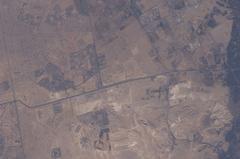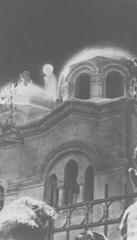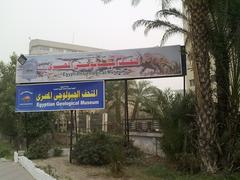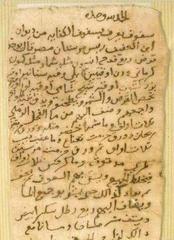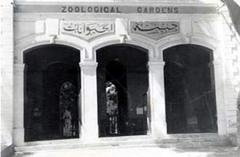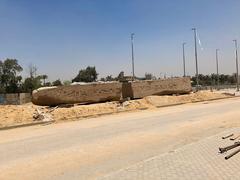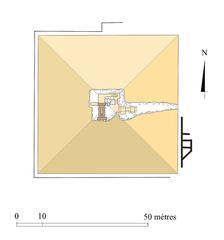
Pyramid of Userkaf: Visiting Hours, Tickets, and Comprehensive Guide to Saqqara’s Historic Site
Date: 03/07/2025
Introduction: The Pyramid of Userkaf and Its Importance
The Pyramid of Userkaf, located within the ancient necropolis of Saqqara in Egypt’s Giza Governorate, offers a remarkable window into the transformative Fifth Dynasty (circa 2494–2345 BCE). As the founder of this dynasty, Pharaoh Userkaf initiated pivotal political and religious reforms, reflected in the architectural features and layout of his mortuary complex. Unlike the grand pyramids of the Fourth Dynasty at Giza, Userkaf’s pyramid is emblematic of a shift toward solar worship and evolving funerary traditions, most notably through its unique south-oriented mortuary temple and focus on the cult of the sun god Ra.
Today, the monument appears as a heavily eroded conical mound, the result of centuries of stone robbing and natural decay. Despite its ruined state, the Pyramid of Userkaf remains a significant archaeological and cultural landmark, offering insights into ancient Egyptian statecraft and beliefs. Situated approximately 20 to 30 kilometers south of Cairo, it is an accessible highlight within the broader Saqqara archaeological zone—home to the Step Pyramid of Djoser and other notable tombs.
This comprehensive guide provides all the essential information for visiting the Pyramid of Userkaf, including historical background, religious significance, site layout, visitor hours, ticketing, travel tips, and practical advice for a rewarding experience.
For further background and logistics, see:
The Brain Chamber, Sharm Club, Egipto Exclusivo.
Historical Context: Userkaf’s Legacy and the Dawn of the Fifth Dynasty
Political and Religious Shifts
Userkaf’s reign marked a period of political and religious transition. Moving away from the monumentalism of the Fourth Dynasty, his rule introduced new religious ideologies, most notably the elevation of Ra, the sun god, to supreme status. This shift is embodied in the establishment of the first sun temple and the architectural orientation of his complex at Saqqara (Historical Eve).
Architectural Innovations
Constructed circa 2490 BCE, the pyramid originally stood 49 meters high with a base of 73 meters per side. Built from local limestone with a fine Tura limestone casing, its stepped core—an economical but less durable method—led to significant deterioration once the casing was removed (Cleopatra Ancient Egyptian Mummy). The mortuary temple, uniquely positioned on the pyramid’s south side, and an associated cult pyramid for the queen, reflect evolving funerary practices.
Bureaucracy and Restoration
Archaeological finds indicate a sophisticated bureaucracy supporting Userkaf’s building projects. The complex underwent periods of neglect and restoration, including significant repairs under Ramesses II and reuse as a cemetery in later periods (Wikipedia).
Religious Significance: Solar Worship and Funerary Traditions
Userkaf’s pyramid complex was at the heart of the Fifth Dynasty’s emphasis on Ra and solar worship. The mortuary temple and the pyramid itself served both as the royal tomb and as a center for the king’s cult and solar rituals (Egypt Mythology). While the interior lacks extensive decoration, nearby Fifth Dynasty pyramids contain early Pyramid Texts, shedding light on beliefs about the afterlife and the king’s divine role.
Userkaf’s architectural and religious innovations influenced subsequent pyramid construction and established traditions that endured throughout the Old Kingdom.
Site Layout and Visitor Navigation
The Pyramid of Userkaf is the centerpiece of a mortuary complex that includes the main pyramid, a south-oriented mortuary temple, an offering chapel, and the remains of a causeway. The complex is enclosed by a wall, and the temple’s red granite pillars and basalt flooring hint at its former grandeur. The queen’s pyramid, now a mound of rubble, lies nearby.
The site is less crowded than Giza, allowing for peaceful exploration. The sandy, uneven terrain requires sturdy footwear.
Present Condition, Conservation, and Archaeological Research
Current Condition
Today, the Pyramid of Userkaf appears as a conical mound of rubble, known locally as “el-haram el-makherbish.” The original core and substructure—featuring a descending passage and burial chamber—remain underground, though not accessible to visitors.
Conservation Efforts
Preservation efforts are limited due to the site’s fragility. The Ministry of Tourism and Antiquities manages stabilization and restricts access to unstable areas. Plans are underway to enhance site interpretation and visitor facilities as part of broader improvements at Saqqara.
Recent Discoveries
Ongoing archaeological missions, employing cutting-edge technologies like ground-penetrating radar, continue to uncover new information. Notably, the 2025 discovery of Prince Userefre’s tomb near the pyramid has enriched our understanding of the royal family and funerary practices.
Visiting Information
Location and Access
The Pyramid of Userkaf is situated in Saqqara, about 25–30 kilometers south of central Cairo. The site can be reached by car, taxi, or guided tour. Public transportation is limited, but ride-hailing services like Uber are available in the area (Touristlink).
Visiting Hours
- Saqqara Archaeological Complex: Open daily from 8:00 AM to 4:00 PM (hours may vary seasonally or for special events).
- Pyramid of Userkaf: Exterior accessible during complex hours; interior is not open to the public for safety and conservation reasons.
Tickets and Entry Fees
- General Saqqara Ticket (includes Pyramid of Userkaf): 200–250 EGP for adults (approx. $6–8 USD). Discounts for students and Egyptian nationals.
- Tickets: Purchase at the main Saqqara entrance; online ticketing may be available (Egipto Exclusivo; egymonuments.com).
Facilities and Amenities
- Restrooms, a small café, and shaded rest areas are located near the main entrance.
- There are no dedicated amenities at the pyramid itself. Bring water, sun protection, and snacks.
Guided Tours and Visitor Experience
Guided tours are strongly recommended for historical context and navigation. Licensed guides can be hired at the entrance or arranged in advance. Tours typically include the Step Pyramid of Djoser and other Saqqara highlights.
Special archaeological events or exhibitions may be held at Saqqara—check official sources for updates.
Accessibility and Safety
- Terrain: Sandy and uneven; not suitable for wheelchairs or those with limited mobility.
- Safety: Climbing on ruins is prohibited. Security staff and signage are present throughout the site.
Photography and Conduct
- Photography is allowed outdoors; use of tripods may require extra permission.
- Drones are prohibited without authorization.
- Dress modestly; littering is forbidden.
Best Times to Visit
- Season: October–April for milder temperatures (20–28°C/68–82°F).
- Timing: Early morning or late afternoon for best light and minimal crowds.
Nearby Attractions and Itinerary Suggestions
- Step Pyramid of Djoser
- Pyramid of Teti
- Imhotep Museum
- Dahshur Pyramids (Bent and Red Pyramids)
- Memphis (ancient capital)
A full Saqqara visit (including Userkaf’s pyramid) typically takes 2–4 hours. Many tours combine Saqqara with Dahshur or Memphis.
Practical Tips for Visiting
- Bring at least 1–2 liters of water per person.
- Wear light, breathable clothing, a hat, and sunglasses.
- Carry cash in small denominations.
- Hire a licensed guide for context and navigation.
- Respect all site regulations; do not touch or climb ruins.
- Arrange transport in advance; taxis are limited at the site exit.
- Be wary of unofficial guides or touts.
Frequently Asked Questions (FAQ)
Q: What are the visiting hours for the Pyramid of Userkaf?
A: The Saqqara complex is open daily from 8:00 AM to 4:00 PM; hours may vary seasonally.
Q: How much are tickets?
A: 200–250 EGP for adults; discounts available for students and locals. Entry includes access to the Pyramid of Userkaf area.
Q: Can I go inside the Pyramid of Userkaf?
A: No, the interior is closed to the public for safety and conservation reasons.
Q: Are guided tours available?
A: Yes, guides can be arranged at the entrance or booked in advance.
Q: Is the site wheelchair accessible?
A: No, due to uneven terrain and lack of paved paths.
Summary and Visitor Recommendations
The Pyramid of Userkaf stands as a testament to the dynamic evolution of ancient Egypt’s religious, political, and architectural traditions. Its modest scale, innovative temple orientation, and focus on solar worship mark a pivotal shift in royal funerary customs. Despite its ruined state, the pyramid offers a contemplative and historically rich experience, especially when explored as part of a comprehensive Saqqara tour.
Ongoing archaeological discoveries and conservation efforts continue to shed light on Userkaf’s reign and the significance of his mortuary complex. For travelers seeking a quieter and more reflective alternative to the Giza Plateau, the Pyramid of Userkaf and its surrounding monuments make for an unforgettable journey into Egypt’s ancient past.
Plan your visit by checking current hours, securing tickets, and considering a guided tour for an enriched experience. For further information and curated audio guides, download the Audiala app and follow related Egyptology channels.
Sources
- The Brain Chamber
- Sharm Club
- Egipto Exclusivo
- Egymonuments.com
- Historical Eve
- Cleopatra Ancient Egyptian Mummy
- Touristlink
- Our Travel Passport
- Local Guide to Egypt
- Sun Pyramids Tours
- GPSmyCity















